Hydrogen is a versatile and clean-burning fuel that has the potential to play a significant role in the transition to a sustainable energy future. It can be produced using a variety of methods, including steam methane reforming, electrolysis, coal gasification, biomass gasification, photoelectrochemical and solar thermochemical water splitting, and biological water splitting. Each hydrogen production technology has its advantages and disadvantages, and the choice of technology depends on factors such as cost, availability of resources, and sustainability.
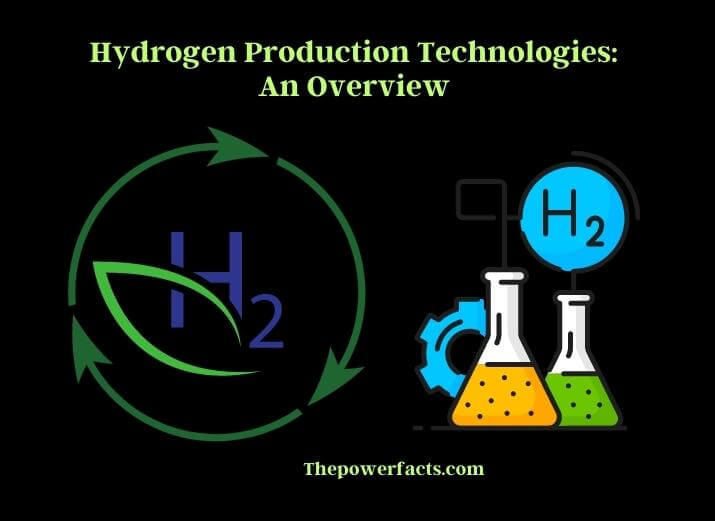
We will provide an overview of the different hydrogen production technologies, including their working principles, advantages, disadvantages, and applications. We will also discuss the challenges facing hydrogen production technologies and the future outlook for hydrogen as a sustainable source of energy.
Steam Methane Reforming (SMR)
Steam Methane Reforming (SMR) is one of the most common methods used for hydrogen production, accounting for around 95% of global hydrogen production. It involves reacting natural gas, methane, or other hydrocarbons with high-temperature steam in the presence of a catalyst to produce hydrogen and carbon monoxide. The carbon monoxide is then further reacted with steam through the water-gas shift reaction to produce additional hydrogen and carbon dioxide. The resulting gas mixture is known as synthesis gas or syngas.
SMR has several advantages as a hydrogen production method, including its high efficiency, low capital, and operating costs, and the availability of feedstocks. It also has the ability to produce large quantities of hydrogen and can be easily integrated into the existing natural gas infrastructure.
SMR has several drawbacks, including the release of large amounts of greenhouse gases, such as carbon dioxide, during the process. SMR also relies on the availability of fossil fuels, which are non-renewable resources. The production of SMR also requires high temperatures and pressures, which can be energy-intensive and expensive.
Despite its drawbacks, SMR remains a dominant method of hydrogen production due to its high efficiency and low cost. Researchers are actively working on developing carbon capture and storage technologies to reduce the greenhouse gas emissions associated with SMR, making it a more sustainable option for hydrogen production.
Electrolysis
Electrolysis is another commonly used method for hydrogen production that involves the splitting of water molecules into hydrogen and oxygen using an electrical current. This method can use various sources of electricity, including renewable sources such as wind and solar power.
In electrolysis, water is separated into its components by passing an electric current through it. The electric current causes the water molecules to break down into their constituent parts, hydrogen, and oxygen. The hydrogen gas is then collected and purified for use as fuel.
Electrolysis has several advantages as a hydrogen production method, including its ability to use renewable energy sources, such as wind and solar power. This makes it a clean and sustainable method of hydrogen production. Electrolysis can also be used for small-scale production of hydrogen, such as in fuel cells for portable devices.
Electrolysis also has some drawbacks. It is currently more expensive than SMR and other hydrogen production methods, primarily due to the high cost of electricity required for the process. It also requires a significant amount of water, which can be a limiting factor in regions with water scarcity.
Researchers are working on improving the efficiency and reducing the cost of electrolysis, making it a more viable option for large-scale hydrogen production. Advancements in renewable energy sources, such as the development of more efficient solar cells and wind turbines, are also expected to make electrolysis a more sustainable and cost-effective option for hydrogen production in the future.
Coal Gasification
Coal gasification is a process that involves converting coal into a gas mixture that contains hydrogen gas, carbon monoxide, and carbon dioxide. The process involves heating coal in the presence of steam and oxygen, which produces a gas mixture that is then separated, and the hydrogen gas is purified. Coal gasification is a significant source of hydrogen gas in China, but it is an energy-intensive process that produces significant carbon emissions.
Biomass Gasification
Biomass gasification is a process that involves converting organic matter such as wood, agricultural waste, or municipal solid waste into a gas mixture that contains hydrogen gas, carbon monoxide, and carbon dioxide. The process involves heating the biomass in the presence of steam and oxygen, which produces a gas mixture that is then separated, and the hydrogen gas is purified. Biomass gasification is a sustainable method of hydrogen production that can reduce greenhouse gas emissions and provide a source of renewable energy.
Photoelectrochemical (PEC) Water Splitting
Photoelectrochemical (PEC) water splitting is a method of hydrogen production that involves splitting water into hydrogen and oxygen using solar energy. The process involves using a semiconductor material that absorbs sunlight and generates electrons. The generated electrons then react with water molecules, producing hydrogen gas and oxygen gas. PEC water splitting is a promising method of hydrogen production that can be powered by renewable energy sources.
Solar Thermochemical Water Splitting
Solar thermochemical water splitting is a hydrogen production method that uses concentrated solar energy to split water molecules into hydrogen and oxygen. It involves the use of a thermochemical cycle, which uses high-temperature chemical reactions to drive the water-splitting reaction.
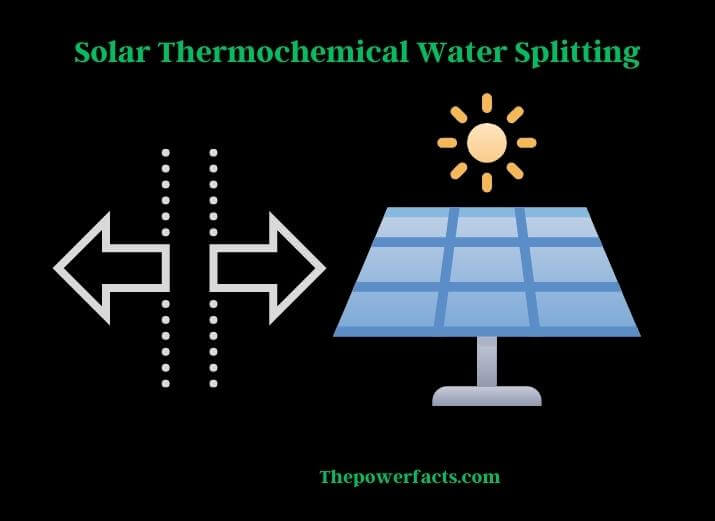
In this method, solar energy is concentrated using mirrors or lenses to create high temperatures, which are used to drive a series of chemical reactions that release hydrogen from water molecules. The released hydrogen is then collected and purified for use as fuel.
Solar thermochemical water splitting has several advantages as a hydrogen production method. It is a clean and sustainable method that does not produce any greenhouse gases or other pollutants. It can also be highly efficient, as it can utilize the entire solar spectrum to generate high temperatures for chemical reactions. This method can be used in conjunction with other solar energy systems, such as solar panels.
Solar thermochemical water splitting also has some challenges. One of the major challenges is the development of highly efficient and cost-effective materials for the thermochemical cycle. These materials must be able to withstand high temperatures and corrosive environments while maintaining their structural integrity. Another challenge is the scalability of the process, as it is currently limited to laboratory-scale experiments.
Biological Water Splitting
Biological water splitting is a method of hydrogen production that mimics the process of photosynthesis in plants. The process involves using bacteria or algae to convert water into hydrogen gas and oxygen gas.
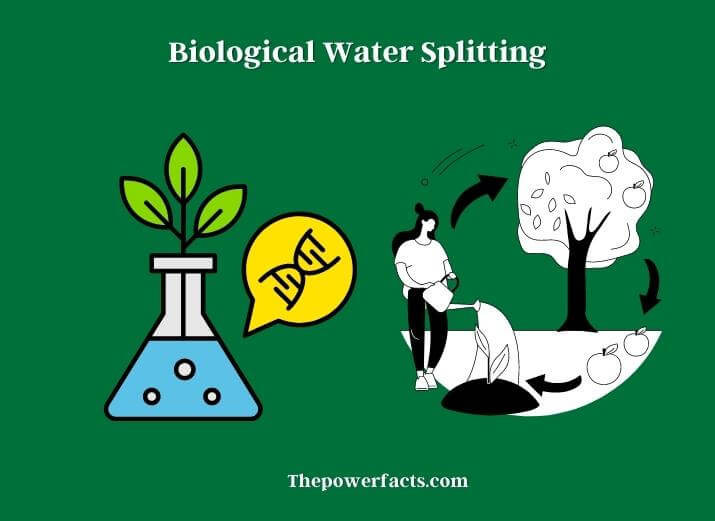
The bacteria or algae are genetically engineered to produce hydrogen gas using sunlight, which can be collected and purified. Biological water splitting is a sustainable method of hydrogen production that has the potential to be powered by renewable energy sources.
Comparison of Different Hydrogen Production Technologies
Hydrogen production technologies can be compared based on several factors, such as efficiency, cost, scalability, and environmental impact. Here we will compare four of the most commonly used hydrogen production technologies: steam methane reforming (SMR), electrolysis, photoelectrochemical (PEC) water splitting, and solar thermochemical water splitting.
Efficiency
In terms of efficiency, PEC water splitting and solar thermochemical water splitting are the most promising methods as they utilize solar energy to split water molecules into hydrogen and oxygen, making them clean and sustainable. SMR and electrolysis are less efficient, as they require energy input in the form of natural gas or electricity to drive the water-splitting reaction.
Cost
SMR is currently the most cost-effective method for large-scale hydrogen production, as it uses natural gas as a feedstock, which is widely available and relatively inexpensive. Electrolysis is more expensive, as it requires a significant amount of electricity to drive the water-splitting reaction. PEC water splitting and solar thermochemical water splitting is still in the early stages of development and is currently more expensive than SMR and electrolysis.
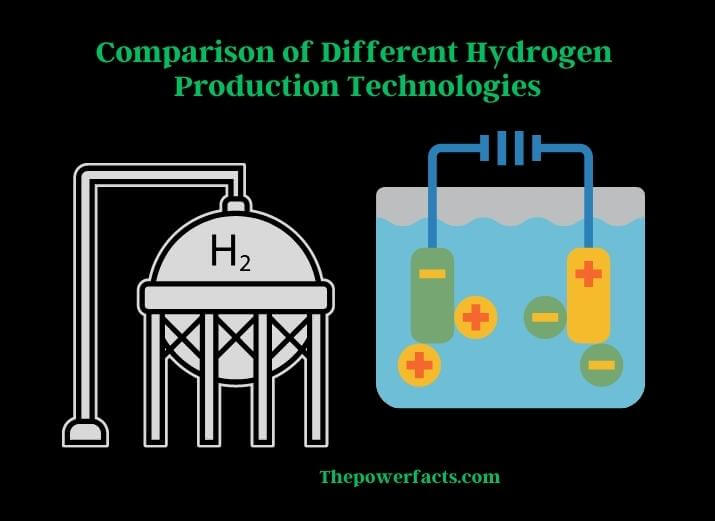
Scalability
SMR and electrolysis are the most scalable methods for hydrogen production, as they are already being used on an industrial scale. PEC water splitting and solar thermochemical water splitting are still in the laboratory-scale experimental phase and have not been demonstrated at a commercial scale.
Environmental Impact
SMR and electrolysis both have environmental impacts. SMR produces carbon dioxide emissions, contributing to climate change, and electrolysis requires electricity, which may come from non-renewable sources. PEC water splitting and solar thermochemical water splitting are clean and sustainable methods that do not produce any greenhouse gases or other pollutants.
Each hydrogen production technology has its own advantages and disadvantages, and the most suitable method depends on the specific application and requirements. SMR is currently the most cost-effective and scalable method for large-scale hydrogen production, while PEC water splitting and solar thermochemical water splitting are promising clean and sustainable methods that are still in the early stages of development.
Applications of Hydrogen Production Technologies
Hydrogen production technologies have a wide range of applications across various industries. Here are some of the most common applications of hydrogen production technologies:
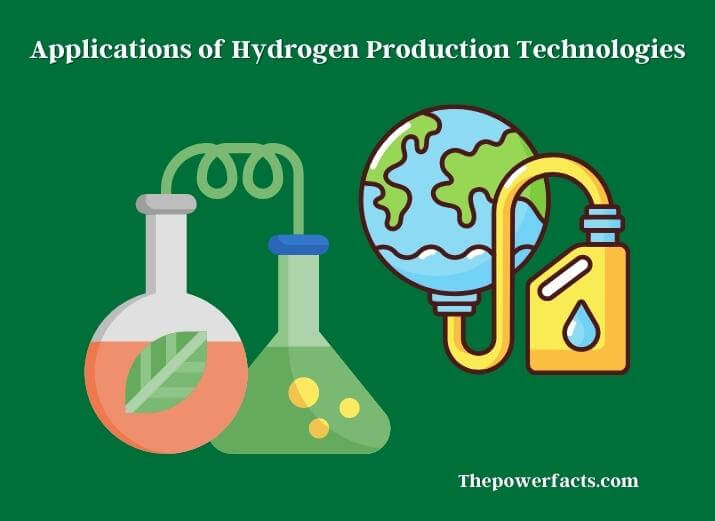
Challenges in Hydrogen Production Technologies
Despite the potential benefits of hydrogen production technologies, there are several challenges that need to be overcome to enable their widespread adoption. Some of the major challenges include:
- Many hydrogen production technologies are currently more expensive than traditional fossil fuel-based technologies. This is due in part to the high cost of the equipment and materials required for hydrogen production, as well as the relatively low economies of scale in the industry.
- Hydrogen production technologies often require large amounts of energy to produce hydrogen, leading to high energy losses and reduced overall efficiency.
- The current infrastructure for hydrogen production, storage, and distribution is underdeveloped, which limits the ability of hydrogen to be used on a large scale.
- Hydrogen is a highly flammable gas, which presents safety challenges for its storage and transport.
- While hydrogen is often touted as a clean and sustainable fuel source, its production can still result in greenhouse gas emissions if not produced using renewable energy sources or carbon capture technologies.
- The production of hydrogen requires large amounts of water and energy, which can strain local resources and have negative environmental impacts if not managed sustainably.
Future Outlook of Hydrogen Production Technologies
Hydrogen production technologies have the potential to play a significant role in the transition to a sustainable energy future. The adoption of hydrogen fuel cells in the transportation sector is increasing, and the development of new hydrogen production technologies is ongoing. The use of renewable energy sources to power hydrogen production technologies is also increasing, reducing carbon emissions and making hydrogen gas a more sustainable alternative to traditional fossil fuels.
You have to know what are energy savings opportunities and how can they benefit you. Click here for details.
The Bottom Line
In conclusion, hydrogen production technologies have the potential to transform various industries by providing a clean and sustainable source of energy and feedstocks. From steam methane reforming to solar thermochemical water splitting, there are a variety of different methods for producing hydrogen, each with its own advantages and challenges.
While hydrogen production technologies are still in the early stages of development, there is growing interest in the industry and a significant amount of investment going into research and development. As costs continue to come down and efficiency improves, hydrogen could become a more viable and attractive alternative to traditional fossil fuel-based technologies.
There are also significant challenges that need to be addressed in order to enable the widespread adoption of hydrogen production technologies. These include cost, energy efficiency, infrastructure, safety, greenhouse gas emissions, and resource availability. Addressing these challenges will require continued investment and collaboration across industry, government, and academia.
Hydrogen production technologies represent an exciting and promising area of innovation with the potential to help address some of the world’s most pressing environmental and energy challenges. While there is still much work to be done, the future of hydrogen looks bright.